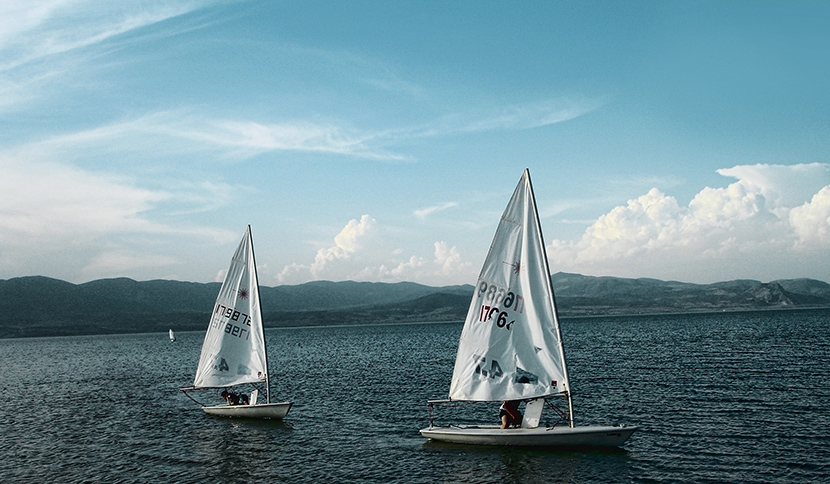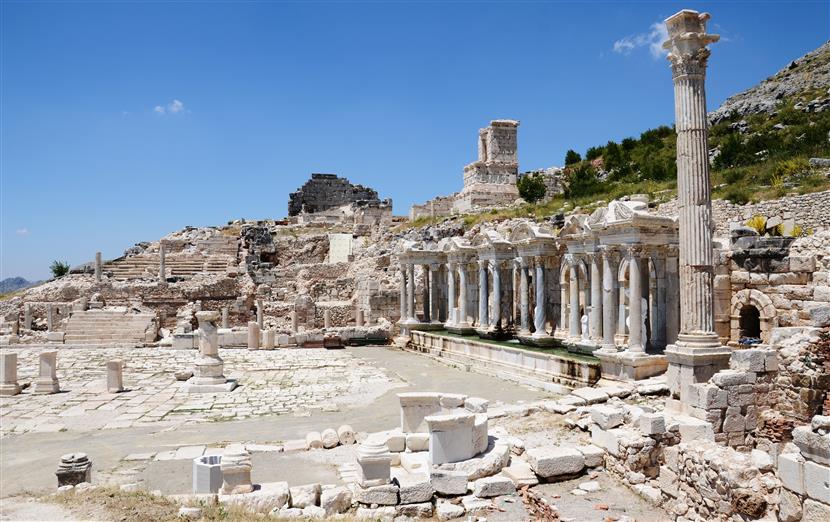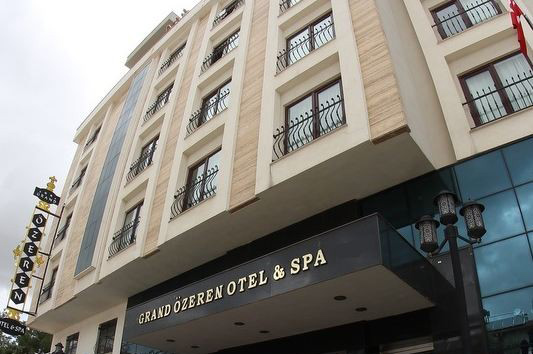About Burdur
Burdur is in Turkey's Lakes District, inland from the Mediterranean coast.
Burdur is a small city with 250.000 inhabitants, 80.000 of whom live in the city center. It is one of the oldest settlements in the world, dating back to 7000 BC. Burdur is a cosy city offering natural and historical treasures but not much of a nightlife. One day is more enough for the city center for examining the architecture, visiting the museum, meeting with the warm people and tasting the delicious food. Another day should be spend for the surroundings; ancient city, cavern and the lakes. The origin of the name Burdur has several rumors. In Greek mythology, Ulis, escaping from the gods heard Ezostas ("stop here" in Latin) and located here. The translation of the Ezostas (Burada Dur) transforms into Burdur. Another rumor is that the name comes from the Tumulus near the train station, Polydorion. One rumor is that the name is transformed from the word "Limobrama", old name of the region meaning "the land of the lakes". There are at least ten other rumors.
Burdur has a great historical treasure of 10,000 years with an existence during the Seldjuk, Ottoman and Republic periods under the Turkish domain for 1,000 years after a the ancient and medieval existence of 9,000 years. Burdur is a big historical tourism city with its ancient cities of Sagalassos, Cbyra, Kremna, of which each is an Ephesus itself, its mosques, mansion and caravanserais of the Turkish periods. Burdur has the potentials of “Nature Tourism” with the Insuyu Cave, its lakes, upland, skiing areas and of “Folkloric-Authentic Tourism” by the Teke Region, being a Yoruk-Turkmen culture centre and its traditional life-style. 
.png)
The tourism sector in Burdur is a potential, unexplored field. Burdur is awaiting professional tourism entrepreneurs and sectoral investors. Among the tourism infrastructure investment fields in Burdur;
Star awarded hotels, restaurants, recreational, entertainment and similar facility investments, tourism school and tourism personnel training investments, Burdur specific souvenir production, promotional products (books, brochures, periodicals, posters, albums, CD, DVD etc. production), regional food goods with touristic value, tour and guidance investments are expecting their investors.
Get around
Burdur is not a big city so walking is advised to tour all of the city. The city center has mainly few main roads crossing each other and there is no need for a public transportation. If needed, dolmus (little buses) may be used. It is hard to pick a taxi from the roads so calling a taxi is advised. The taxis are secure and drivers almost never try to cheat, but the rates are relatively more expensive than other cities.
Burdur people are very kind and helpful for directions but there may be some communication problems with elderly people. Try to approach youngsters to communicate in English.
See
Burdur Museum is a must see, it offers more than you can expect from such a little city. The museum is awarded a special prize from European Museums Forum in 2008. You may either buy a ticket or buy a Museum Card which is 4-5 times of a regular ticket price. A museum card is valid for a year and allows the bearer to enter most museums for free. Beside the museum, there is a little antique store with not much to offer but still, it is worth a look. (Bargaining is advised and keep in mind that some old coins cannot be taken out of the country: Even carrying them may violate laws.)
Burdur Yukarı Pazar
A traveller should visit Yukarı Pazar (Upper Bazaar) which is around the Ulu Cami (which is the most remarkable mosque in Burdur) Although there is too little to buy as a souvenir, the atmosphere is lovely. You will feel like travelling in time, 30 years before present time. If accidentally the bazaar day is catched, incredibly tasty fruits should be bought without hesitation. In the mid-day, you may encounter the part of the funeral ceremony and final prayer for the deceased in Ulu Cami. Although it is a depressing sight, if you are still interested, you should avoid mixing with the crowd and taking photographs. No one will offend you, but it is considered to be rude. From Ulu Cami, the perfect route will be towards the Eski Hamam (Old Turkish Bath). Although the hamam is ruined, the narrow curved roads with cobblestones between architecturally beautiful houses gives a warm feeling. Try to communicate with the elderly people sitting on the sidewalks (you can always see them). Even if they know no English at all, they will welcome you, even invite you for a cup of tea. In Burdur, people are not bigots, but still do not mention alcohol and/or gay related subjects, especially with elderly people.
Hotels
The recent hotel with 4 stars is Grand Ozeren, near the stadium. The rooms are good and you can use the Sauna and Turkish Bath. 
If you can spare a little bit, there are some hotels near the Salda Lake with a good view. Very nice hotel is Hotel Lago Di Salda in Yeşilova/Burdur. Hotel Lago Di Salda have 23 standart room, 2 suite room. You can use the Sauna and Turkish Bath.
Economy of Burdur
Burdur is a province in the Seas’ Region of Western Mediterranean; at one of cross-point with the highest traffic density of our country, having a railway connection, located 20km away from the airport and 120 km away from the sea-port.
Burdur, being at the cross-point of roads and the economic advantages at the same time, houses in its entity various super-ground and sub-ground assets. Burdur itself is an “Economic Geography” with these features and its regional location.
Burdur, which is the jumping point of the region economy; is a nice province of the Western Mediterranean, known with its seas and roses, having a rich tourism potential and preserving the folklore attributes of the Teke Region.
Burdur, who has been the champion for long years in the educational competition in Turkey; is also the rising star of the Western Mediterranean Region with its university, named after the first parliamentarian of Burdur, Mehmet Akif Ersoy, which has reached 17 thousand students in a short time.
The economic characteristics of Burdur; is developing in four main sectors as STOCKBREEDING, STOCKBREEDING RELATED AGRICULTURE, FOOD AND AGRICULTURAL MACHINERY AND MERBLE INDUSTRY AND TOURISM.
Economy of Burdur: is primarily based on Agriculture and Stockbreeding and related to these developing “Agricultural Machines Industry”.
As agriculture and stockbreeding related food industry branches, lead by the Sugar Plant, food industries like meat, milk and milk products, kadayif, pasta, feed stuff, flour, halwa, caper, pickle and similar food industries.
Burdur has a strategic importance in the food industry, meat-milk production and stockbreeding of culture race broods. The reason is that Burdur is somehow the backyard of Antalya, Turkey’s greatest tourism and consumption centre. Burdur is a “Food Production Centre” directly next to Antalya.
Burdur daily 800 t milk is produced in Burdur, of which only 10% are processed. “Dairying in Burdur” at EU standards is one of the most attracting food investment fields of Turkey. There 145 Thousand cattle, 180 Thousand ovine and 160 Thousand poultry in Burdur.
Burdur has with all of its aggregation and potential an important position in terms of meeting the brood heifer needs of our country
In our province, where Turkey-wide qualitative heifer stockbreeding and sales are performed, 97% of the cattle are culture races and the regarding the type of facilities, a transition process from family stockbreeding to farm system is being experienced.
In terms of agriculture and stockbreeding related industry; combine harvester, haymaker, plow, drill, trailer, sillage machine, bailing machine, feed grinder and mixer machine, grain and chickpea mowing machines, milk transport and cooling tanks, bakery oven, farm system stockbreeding machines and equipment, greenhouse and drop irrigation plastic pipe industry have developed.
As promotion fields in the agriculture, stockbreeding and dairy sector; government promotions are provided regarding investment, grouping, organized stockbreeding expertise regions, operation, R&D, strategic and ecological food, strategic seed production and animal race development, technology, employment etc.
The Marble Sector of Burdur, which started its’ rise in 2010 and became the locomotive of Burdur’s economy, has presented a great development with its’ BURDUR BEIGE brand. Burdur is famous for its worldwide known marble and its’ BURDUR TRAVERTINE. All around Burdur is covered with marble and travertine resources with high reserves. At present, there are 70 marble quarries, more than 100 marble processing facilities and 7 marble processing facility erection facilities in Burdur and Burdur has an annually by 25% growing NATURAL STONE SECTOR. “Burdur Beige”, mentioned along with Burdur and got a brand, is a world known and demanded marble type. 85% of Burdur Beige, exploited at quarries in Burdur and of which only 15% can be processed, is exported to 27 countries worldwide. In terms of natural stone and mining sector, investments are provided government promotions in the fields of mine and quarry research, investment, operation, R&D, marble processing, chrome etc. ore enrichment, technology renovation and employment and the like.
Beside this, also the Soil-Cement-Brick industry, wood, forest products and furniture industry, construction building industry, spare parts machine industry, textile machines, weapon, plastic industry and off the hook textiles and worldwide appreciated music instruments industry have developed in Burdur.
AREAS WAITING FOR INVESTMENTS
1. Feedmills are needed. Current feedmills are only able to meet 15% of the demand.
2. Dairy processing facilities; currently 10% of produced milk is processed in Burdur. The rest is sent to the other cities as raw milk.
3. Agricultural and food machinery and equipment
4. Red meat and food milk production farms are needed to be established. Sheep and goats meat and milk production farms. (IPARD support is available)
5. Leather factories
6. Livestock , vaccine, insemination system and medical fabrication
7. Marble factories
8. Factories for utilization of granite and marble sawing powder wastes
9. Marble powder chemistry factories
10. Energy ( sun, wind etc.) generation systems
11. Forestry products factories. Cold storages.
12. Flour Plants and macaroni factories associated with nourishment.
13. Nourishment factories that process Burdur’s sugar and pekmez
14. Local and natural food production and packaging systems
15. Rest areas needed at historical places such as Sagalassos, Kibyra, Salda Lake, İnsuyu cave and tableland tourism areas.
16. Four or five star hotels in the centrum.
17. Souvenir workshop and factories.
18. Student lodgings.
19. Private hospitals.












